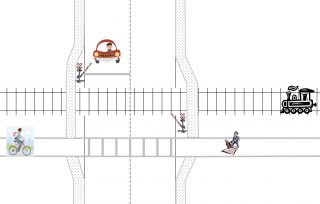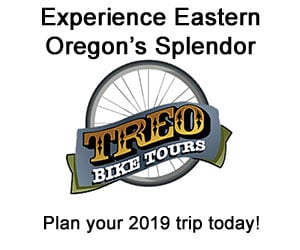
Westbound SE Harney Street. ODOT says stop signs are needed on the path because they’re worried vehicle users on streets like this will wait on railroad tracks for path users to cross.
When we learned the Portland Parks & Recreation bureau planned to install 10 new stop signs on a newly paved, half-mile section of the Springwater Corridor, several readers contacted us to express their frustration.
Stop signs for carfree path users (especially at very low-volume cross-streets) make for inefficient riding and decrease the utility of the trail. Not only that, but psychology and best practices tell us it’s actually less safe to install stop signs that will be ignored by users because people become desensitized to them. It would be much wiser to install caution or yield signs for path users and only require a full stop from the occasional cross-street user.
But that’s not how the Oregon Department of Transportation sees it. They required Portland Parks to install the stop signs as part of their Sellwood Gap project currently under construction.
In a project update from the Parks Bureau on March 7th, Parks’ Community Engagement Coordinator Ken Rumbaugh confirmed that the intersections of SE Umatilla, Harney, Marion, 9th, Linn, 11th, and 13th will become four-way stops (cross-streets currently have yields). Then he added, “In these instances, the cyclist(s) and/or pedestrian(s) will have the right of way.”
After a few days of emailing various staffers of ODOT’s Rail Division (who’s in charge of this area due to the extant railroad line adjacent to the path), I finally got an explanation of their rationale for requiring the stop signs.
ODOT Public Affairs Manager Shelley Snow they deferred to the Federal Highway Administration’s Rails With Trails – Lessons Learned report (PDF). I had emailed her examples of the Alta Planning Rural Design Guide and the AASHTO Bikeway Design Guide — both of which warn against using stop signs for path users. “The guides you mention are great when it comes to those more common types of intersections,” Snow replied. “But apparently trails/paths running right alongside rails are not that common.”
BikePortland relies on financial support from readers like you.
Please join hundreds of other readers and
subscribe for $10/month or
make a one-time payment today!
This queue of vehicles can spill back across the tracks, putting drivers that obey the law and stop for trail users, in danger.
— ODOT
Snow said there are not design standards ODOT could refer to for this project, only the “lessons learned” from the FHWA. Based on ODOT’s analysis of that FHWA guidance, Snow says their primary concern is that people using cars (and other vehicles) on the cross-streets might end up waiting on the railroad tracks. Here’s how Snow put it:
“The key factor here is that without the stop signs where they are now, the traffic coming from the other direction could get stuck on the tracks waiting for the free flow of path users to go by. Thus, the stop signs were placed to stop the path users, decreasing the chance that road users are stopped on the tracks.”
And here it is put another way by ODOT Rail Crossing Safety Manager Rick Shankle,
“There are three different modes of transportation, on three different alignments, intersecting in one place. The train has the right-of way over the other users, and the motor vehicles must yield to pedestrian use on the trail. The STOP sign on the trail intersection with each of these streets, and the STOP signs on the streets essentially make each of these intersections a 4-way stop, and reduce the potential for motor vehicles to stop on the tracks while waiting for a pathway user to cross the street.”
Snow also provided me with a document titled Springwater Study that states,
“According to Oregon law, once a pedestrian sets foot in the crosswalk or multi use path, vehicles approaching from both directions must stop and remain stopped until the pedestrian exits the driver’s lane, plus half of an adjacent lane. In locations near railroad tracks this queue of vehicles can spill back across the tracks, putting drivers that obey the law and stop for trail users, in danger of collisions with trains using the railroad tracks. Not only is this a safety concern, but Oregon has long had a law in the vehicle code prohibiting a vehicle from stopping, standing, or parking on a grade crossing or otherwise interfering with rail operations.”
Snow said the City of Portland, Parks bureau, ODOT Active Transportation staff and railroad representatives all agreed on the design.
— Jonathan Maus: (503) 706-8804, @jonathan_maus on Twitter and jonathan@bikeportland.org
Never miss a story. Sign-up for the daily BP Headlines email.
BikePortland needs your support.
The post Here’s why Portland Parks will install stop signs on the Springwater appeared first on BikePortland.org.
from Latest headlines from BikePortland https://ift.tt/2T6qMWX


No comments:
Post a Comment